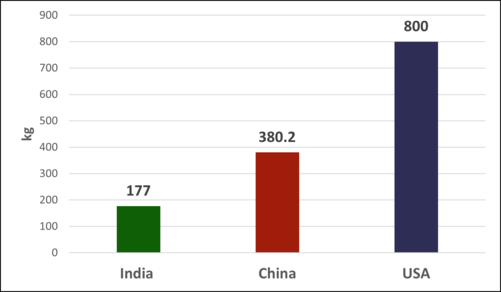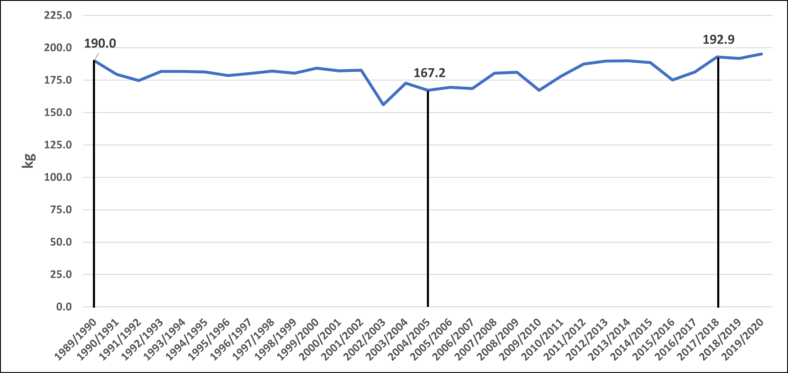One of the world’s biggest strikes is currently taking place. Millions of Indian farmers are protesting against the new agriculture laws adopted by the government and its autocratic leader Narendra Modi, effectively threatening the livelihoods of the most vulnerable parts of Indian society.
Even as corporate transnational agribusiness continues to exert greater control over global agriculture with each passing day through big-ticket mergers and acquisitions and game-changing policy reforms by complaint governments, its conflict with localised peasants and their farm-systems have been in full display for the last few months in India. Led by the big food-growers of Northern India, millions of farmers belonging to various peasant classes, have locked horns with the government over the three Farm Laws passed in September, 2020. Their movement has now intensified under the leadership of the Samyukt Kisan Morcha (United Peasant Front), an umbrella organisation of 40 major farmer unions, including some pan-Indian left unions, from across the country. Anywhere between 200,000 to 300,000 farmers are camping at three different (massively reinforced) border-points of the National Capital New Delhi for the last couple of months and recently organizing a ‘tractor rally’ on the Republic Day as a parallel to the official tableau display of the Indian state.
The National Democratic Alliance (NDA) government, led by Prime Minister Narendra Modi’s BJP, was re-elected for a consecutive term in 2019 with a handsome majority. Despite the fact that the Akali Dal from Punjab, one the important constituents of the NDA, quit the alliance over the three Farm Laws, the Union government has steadfastly maintained these laws are aimed at providing better marketing opportunities and improved technology for Indian farmers. First, the Farmers’ Produce Trade and Commerce (Promotion and Facilitation) Act, 2020 allows the free play of private traders in markets that were regulated by the government via the APMC (Agricultural Produce Marketing Committee) Acts. The government contends this as necessary for improving the price offers that farmers receive for their crops. The second law, The Farmers (Empowerment and Protection) Agreement on Price Assurance and Farm Services Act, 2020, relates to the facilitation of contract farming, thereby placing the Indian farmer in the global corporate food chains, again with the promise of raising farm incomes. Finally, the Essential Commodities (Amendment) Act, 2020 removes several crops, including cereals, from the list of essential commodities, effectively removing the private hoarding restrictions on these crops. This is in sync with the idea of the other two Acts to facilitate private players, and the really big ones, to invest and increase their presence in the Indian farm sector.
As is evident now, substantial sections of Indian farmers view these laws with suspicion and as the most explicit and cogent effort till date by the Indian state to give corporate agribusiness a free hand in the farm sector. Global giants like Pepsico or joint ventures between Indian and foreign capital like the Adani-Wilmar tie-up are few examples among many, who are already present in selected value-chains for agricultural commodities potatoes and edible oils and are eyeing to expand their operations in the Indian agriculture sector. A careful analysis of the Indian agricultural scenario helps us in understanding the growing farmer discontent with these laws. Private trade in agricultural commodities have always existed in Indian agriculture. What is at stake here are the wheat and paddy/rice markets, where the government procures a significant share of the output at Minimum Support Prices (MSPs). While the government announces MSPs for nearly two dozen crops, they are really effective for wheat and paddy because of the large-scale post-harvest procurement operations by the government parastatal Food Corporation of India (FCI) and its agencies.
The FCI was established in 1965 amidst the then food-shortages and have played a major role in boosting cereal production through the price support to food-growers. The FCI is also responsible for the distribution of subsidized grains to the population by operating the Public Distribution System (PDS), a crucial state intervention to address the challenges of pervading hunger in the country. The National Food Security Act (NFSA), passed in 2013 mandates the provision of subsidized food via the PDS to 67 percent of the population. In 2020, as part of the Covid relief, excess grains were distributed under the ambit of the NFSA to around 800 million people, which can be safely assumed to be the number of nutritionally vulnerable population in the country. Farmers fear that with the complete deregulation of the grain markets, big corporate capital will resort to predatory pricing and eventually undermine the FCI operations, thereby exercising a monopoly in the medium- to long-run.
Signing the WTO agreement in 1995 marked the beginning of India’s integration into the global markets, including that for agricultural commodities. Heavy volatility in crop prices along with rationalization of input subsidies with such economic liberalization have meant that farm incomes have stagnated and squeezed between rising costs and inadequate prices. Since the late nineties, the stagnation in income from commercial crop cultivation has led to spiraling indebtedness among farmer households, causing nearly 400,000 farm suicides till date. Food growers, particularly rice and wheat farmers, have avoided this agrarian crisis, primarily due to the MSPs and public procurement operations. While the government has claimed that these laws will free the farmers from the middlemen commission agents and allow them to sell their crop directly to big companies, the farmers have greater apprehension regarding the ‘distant and unknown corporate buyer’ than the ‘inefficient commission agent’, who are mostly locals and belong to the same brethren.
Of the total cereal output in India, approximately 30-35 percent is purchased by the government at guaranteed prices and roughly another 30 percent of the output is used for self-consumption. Rest of the grains are privately traded. Thus, the private sector (mostly smaller trading entities) in grain trade is almost equally balanced by the public operations. These government operations are large. In a single winter crop season in 2020, the FCI has purchased wheat of the value of INR 750 bn (EUR 8.5 bn). The annual food subsidy that the government bears for running the PDS is currently at INR 2.43 tn (EUR 27.5 bn)[1]. With all its implementation shortcomings, where deserving households are sometimes left out of the safety net, this provision of subsidized food is still the centre-piece of the battle against hunger in the country. At the same time, the bargaining power and the accountability that the food-growers enjoy with the government putting in such money is clearly at the risk of disappearing with a full play of corporate interests.
It is ironical that these laws are often justified on the basis of the grossly erroneous notion that India is a ‘food-grain surplus’ country and the government guaranteed prices have led the beneficiary farmers to produce more grains than required. It seldom appeals to the common sense that a ‘food-grain surplus’ nation cannot also rank at the bottom of the Global Hunger Index[2] like she has done for many years now. The large exports of cereals in the last decade and accumulated rice/wheat stocks with the FCI do indicate that substantial part of the domestically produced grains that do not have demand within the country[3]. However, this is more due to the sustained declining trend in grain demand in the country over the last three decades rather than any substantial increase in grain output.
The annual per-capita domestic consumption of cereals in 1990 was 186 kg.[4] For all subsequent years in the three decades from then, it has been lower than this figure. This is a level of consumption that is usually found along with widespread hunger in society. Nations where hunger is a story of the past, the grain demand and absorption per person is much more than this. As a reference, one may note that in 2018, the corresponding figures for USA was around 800 kg (corn used for ethanol production excluded)[5] and for a developing country like China, it was 380.2 kg. In India, the same was 177 kg in 2018. Further decline in grain consumption in India from such already low levels depict the result of neo-liberal economic policies of deregulation and privatization. The latter have pushed various kinds of petty production including peasant farming into deep crisis, stagnated incomes for the masses and exacerbated the problem of undernutrition.
Annual per-capita domestic consumption of cereals in 2018: India, China, USA

Hypothetically, if the average Indian had to merely maintain her annual grain consumption at this low 1990 level of 186 kg for the next thirty years, India would have required a whopping additional 430 million tons of food-grains for the period 1991 to 2020! Clearly, India did not register an increase in grain output of this order. The per-capita domestic grain output was 190 kg in 1990 and had also started declining reaching around 167 kg by 2005. This depicted a situation where food-producers in the country were struggling to keep their agricultural systems intact due to increasing pressure of commercialization, deregulation of inputs and ecological challenges. The only reason they did not slip into a long crisis like other commercial crop farmers was the government support in the form of grain purchases at declared minimum prices. After 2005, there was some recovery in grain output and it is only after 2017 that the per-capita grain output has finally crossed the 1991 mark.
India: Per-capita domestic grain output

The grain surpluses in India that corporate agribusiness is now eyeing for profits is more of an ‘illusory surplus’, not created by any exceptional over-production by farmers but an illusion created by empty and half-filled stomachs over a couple of generations at the bottom half of the population. Grains were accumulated and exported more as million could not afford bare minimum meals. The bottom three-fifth of the population has chronic calorie and protein deficiency by any decent norm of nutrition and this is a challenge that subsequent governments have failed to address meaningfully. If the new farm laws now lead to an undermining of public procurement and the food rationing system that currently exists in India, then that can be identified as the fall of one of the last of the grand social security measures that still exists for the poor and vulnerable in the increasingly dehumanized world. Apart from her farmers, this does not augur well for the majority of Indians as well!
NOTES
- Figures as reported in the Union Budget of the Government of India, 2021
- Indian ranked at 94 out of 107 nation in the 2020 GHI report
- The total grain exported in 1991-2020 is 216.5 million tons, most part of which was in the last decade. The FCI stocks currently stand at 75 million tons of food-grain
- All grain consumption, production and export numbers quoted in this piece are calculated by the author based on the data available at Foreign Agriculture Service, USDA https://apps.fas.usda.gov/psdonline/. For calculating per-capita figures, population data has been sourced from FAOSTAT.
- own calculation; corn producation in total: 1093 kg, 2018